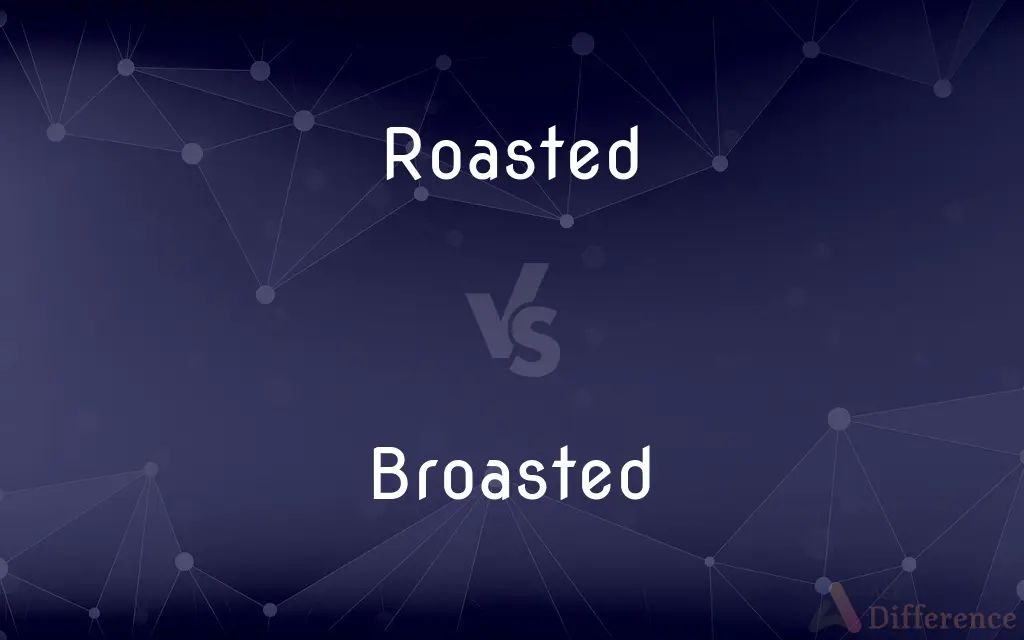Roasted vs. Broasted — What's the Difference?
By Tayyaba Rehman & Urooj Arif — Updated on April 2, 2024
Roasted food is cooked dry in an oven, offering a rich, concentrated flavor, while broasted food combines frying and pressure cooking, resulting in crispy, moist outcomes.

Difference Between Roasted and Broasted
Table of Contents
ADVERTISEMENT
Key Differences
Roasted food is prepared by cooking it in an oven or over an open flame, which allows it to cook slowly, enveloping the food in dry heat. This method caramelizes the exterior, creating a rich and concentrated flavor. On the other hand, broasted food is cooked in a broaster, a specialized piece of equipment that combines deep frying and pressure cooking. This method seals in the food's juices while ensuring a crispy exterior.
When roasting, the food's natural flavors are enhanced due to the slow cooking process and the caramelization of natural sugars. This method is particularly favored for meats and vegetables. Whereas broasting requires the food to be marinated and then cooked at high pressure in a broaster, which cooks the food faster than roasting and retains moisture, making it especially popular for chicken.
Roasting typically does not require the food to be battered or breaded, as the goal is to achieve a flavorful crust through the cooking process itself. Conversely, broasted foods are often coated with a batter or breading before cooking, which contributes to their signature crispy texture.
Roasted dishes are generally considered healthier due to the minimal use of oils or fats in the cooking process. On the other hand, broasting, while locking in moisture and flavor, involves cooking in oil under pressure, which can result in a higher fat content in the final product.
The equipment required for roasting is commonly found in most kitchens, such as an oven or a roasting pan. Meanwhile, broasting requires a specific piece of equipment called a broaster, which is not as commonly available in home kitchens, making broasted dishes more often found in restaurants or commercial settings.
ADVERTISEMENT
Comparison Chart
Cooking Method
Dry heat in oven or over flame
Combination of frying and pressure cooking
Texture & Flavor
Caramelized exterior, rich flavor
Crispy exterior, moist interior
Preparation Requirement
No batter/breading needed
Often battered or breaded
Health Aspect
Generally healthier due to minimal oil use
Higher fat content due to cooking in oil
Equipment Needed
Oven, roasting pan
Specialized broaster
Compare with Definitions
Roasted
Requires no special equipment beyond an oven.
Their new kitchen’s oven made roasting meats and veggies a breeze.
Broasted
Can be richer in fat due to oil use.
Although delicious, broasted foods are higher in calories.
Roasted
Considered a healthier cooking method.
They opted for roasted salmon to keep their meal light and nutritious.
Broasted
Typically involves batter or breading.
Their broasted fish is coated in a secret-recipe batter.
Roasted
Enhances natural flavors through caramelization.
Roasted vegetables bring out a sweetness you can’t get from boiling.
Broasted
Requires specific equipment not commonly found at home.
Installing a broaster has allowed them to expand their menu offerings.
Roasted
Often used for meats and vegetables.
She prepared roasted chicken with herbs for dinner.
Broasted
Cooked in a broaster combining frying and pressure.
The restaurant is famous for its juicy broasted chicken.
Roasted
Cooked with dry heat in an oven or over a fire.
The roasted turkey was the centerpiece of the Thanksgiving dinner.
Broasted
Ensures crispy texture outside, moist inside.
Broasted potatoes have a perfect crunch with a soft center.
Roasted
(of meat) cooked by dry heat in an oven
Broasted
Simple past tense and past participle of broast
Roasted
(of food) cooked by prolonged exposure to heat in an oven or over a fire
Roasted chestnuts
Broasted
Cooked by broasting; fried under pressure.
Roasted
To cook with dry heat, as in an oven or near hot coals.
Roasted
To dry, brown, or parch by exposing to heat.
Roasted
To expose to great or excessive heat.
Roasted
(Metallurgy) To heat (ores) in a furnace in order to dehydrate, purify, or oxidize before smelting.
Roasted
To ridicule or criticize harshly.
Roasted
To honor at or subject to a roast.
Roasted
To cook food in an oven.
Roasted
To undergo roasting.
Roasted
Something roasted.
Roasted
A cut of meat suitable or prepared for roasting.
Roasted
The act or process of roasting.
Roasted
The state of being roasted.
Roasted
Harsh ridicule or criticism.
Roasted
A facetious tribute, as at a banquet, in which the honoree is alternately praised and insulted.
Roasted
Roasted
Roast duck.
Roasted
Cooked by roasting.
Roasted
Simple past tense and past participle of roast
Common Curiosities
What is broasted food?
Broasted food is cooked in a broaster, combining the techniques of frying and pressure cooking to create a crispy exterior and moist interior.
What is roasted food?
Roasted food is cooked through dry heat, typically in an oven, enhancing its natural flavors and textures without the use of added fat.
Can I broast food at home?
Broasting at home is challenging without a broaster, a specialized piece of equipment, making it more common in commercial settings.
How does the taste of roasted food compare to broasted food?
Roasted food has a rich, concentrated flavor with a caramelized surface, while broasted food is known for being exceptionally moist inside with a crispy outside.
Is broasted food healthier than roasted food?
Generally, roasted food is considered healthier due to the lower use of oil, whereas broasted food is cooked in oil, making it higher in fat.
Is there a flavor difference between broasting and roasting?
Yes, roasting brings out the natural sweetness and depth of flavor in foods, while broasting is prized for its unique combination of crispiness and juiciness.
What makes broasted chicken different from fried chicken?
Broasted chicken is cooked in a broaster, which uses pressure cooking along with frying, making it moister and crispier than traditionally fried chicken.
Do I need to marinate food before roasting or broasting?
Marinating is not necessary for roasting but is often used for broasting to enhance flavor and moisture.
How do broasted and roasted foods differ in texture?
Roasted foods develop a caramelized crust, offering a range of textures, while broasted foods are uniformly crispy on the outside and tender inside.
Can broasting be considered a form of frying?
Yes, broasting is a form of frying, but it also incorporates pressure cooking, distinguishing it from standard frying methods.
Why is roasting popular for meats and vegetables?
Roasting enhances the natural flavors of meats and vegetables through caramelization and slow cooking, making it a favored method.
What equipment do I need to roast food?
Basic kitchen equipment like an oven or a roasting pan is sufficient for roasting foods.
Can any food be broasted or roasted?
While many foods can be either broasted or roasted, the methods are best suited to specific types like meats and vegetables for roasting, and primarily chicken for broasting.
Is it possible to achieve a broasted-like texture with an air fryer?
An air fryer can mimic the crispiness of broasting to some extent but without the same moisture level inside due to the lack of pressure cooking.
How do I know when roasted or broasted food is done?
Roasted foods are done when they reach the desired internal temperature and have a caramelized exterior. Broasted foods are typically timed based on the broaster's settings.
Share Your Discovery

Previous Comparison
Supple vs. Flexible
Next Comparison
Melon vs. RockmelonAuthor Spotlight
Written by
Tayyaba RehmanTayyaba Rehman is a distinguished writer, currently serving as a primary contributor to askdifference.com. As a researcher in semantics and etymology, Tayyaba's passion for the complexity of languages and their distinctions has found a perfect home on the platform. Tayyaba delves into the intricacies of language, distinguishing between commonly confused words and phrases, thereby providing clarity for readers worldwide.
Co-written by
Urooj ArifUrooj is a skilled content writer at Ask Difference, known for her exceptional ability to simplify complex topics into engaging and informative content. With a passion for research and a flair for clear, concise writing, she consistently delivers articles that resonate with our diverse audience.















































